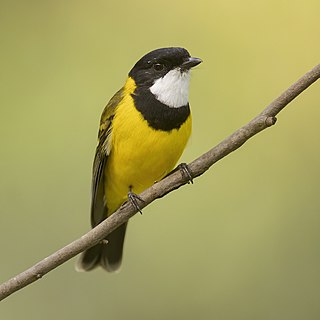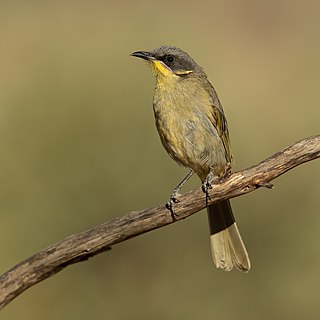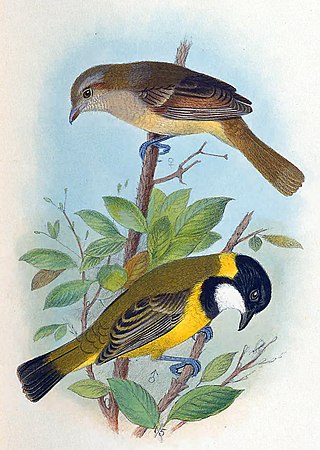
The malleefowl is a stocky ground-dwelling Australian bird about the size of a domestic chicken. It is notable for the large nesting mounds constructed by the males and lack of parental care after the chicks hatch. It is the only living representative of the genus Leipoa, though the extinct giant malleefowl was a close relative.

The black-eared miner is an endangered honeyeater endemic to mallee woodland in south-eastern Australia.

Threatened fauna of Australia are those species and subspecies of birds, fish, frogs, insects, mammals, molluscs, crustaceans, and reptiles to be found in Australia that are in danger of becoming extinct. This article lists species classified as threatened species under the Commonwealth Environment Protection and Biodiversity Conservation Act 1999.

The Australian golden whistler or golden whistler, is a species of bird found in forest, woodland, mallee, mangrove and scrub in Australia. Most populations are resident, but some in south-eastern Australia migrate north during the winter. Its taxonomy is highly complex and remains a matter of dispute, with some authorities including as many as 59 subspecies of the golden whistler, while others treat several of these as separate species. This bird is also known as White-Throated Thickhead in older books.

The yellow-tufted honeyeater is a passerine bird found in the south-east ranges of Australia. A predominantly black and yellow honeyeater, it is split into four subspecies.

Gluepot Reserve is a private protected area located in the Australian state of South Australia in the gazetted locality of Gluepot about 40 kilometres north of the town of Waikerie.

The olive whistler or olivaceous whistler, is a species of bird in the family Pachycephalidae, the whistlers, that is native to southeastern Australia.

Pachycephala is a genus of birds native to Oceania and Southeast Asia. They are commonly known as typical whistlers. Older guidebooks may refer to them as thickheads, a literal translation of the generic name, which is derived from the Ancient Greek terms pachys "thick" + kephale "head". This lineage originated in Australo-Papua and later colonized the Indonesian and Philippine archipelagos to the west and the Pacific archipelagos to the east.

The purple-gaped honeyeater is a species of bird in the family Meliphagidae. It is endemic to semi-arid southern Australia, where it inhabits mallee, tall heath and associated low eucalypt woodland.

The mangrove whistler is a species of bird in the family Pachycephalidae found in South-east Asia.

The Gilbert's whistler is a monotypic species of bird endemic to Australia, scattered in semi-arid zones of southern Australia.

The white-breasted whistler is a species of bird in the family Pachycephalidae. It is endemic to Australia. Its natural habitat is subtropical or tropical mangrove forests.

The redthroat is a small, mostly ground-dwelling species of bird in the family Acanthizidae. It is endemic to Australia, occurring mostly in arid and semi-arid areas containing acacia and chenopod shrublands. The species has a distinctive red throat patch and is able to mimic the calls of numerous other bird species.

The mallee emu-wren is a species of bird in the Australasian wren family, Maluridae. It is endemic to Australia.

The Lord Howe golden whistler, also known as the Lord Howe whistler or Lord Howe Island golden whistler, and locally as the “robin” or “yellow robin”, is a small bird in the whistler family, Pachycephalidae. It is a subspecies of the Australian golden whistler that is endemic to Lord Howe Island in the Tasman Sea, part of New South Wales, Australia.

The black-chinned whistler is a species of bird in the family Pachycephalidae, endemic to Halmahera and adjacent smaller islands in North Maluku in Indonesia.

The rusty-breasted whistler, also known as the fulvous-tinted whistler, is a species of bird in the family Pachycephalidae. It is endemic to Indonesia, where it ranges from Java east to Alor and north to the Selayar Islands.

The Yathong Nature Reserve is a protected nature reserve that is also a nationally and internationally recognized biosphere situated in the central-western region of New South Wales, in eastern Australia. The 107,240-hectare (265,000-acre) reserve was listed by UNESCO in 1977 as a Biosphere Reserve under the Man and the Biosphere Programme (MAB). The reserve is significant for its biodiversity in both native plant and animal species. Cultural heritage and historical grazing activities add to the significance of this site as a conservation area.

The Charcoal Tank Nature Reserve is a protected nature reserve in the central western region of New South Wales, Australia. The 86.4-hectare (213-acre) reserve is situated 10 kilometres (6.2 mi) south of West Wyalong and may be accessed via the Newell Highway and The Charcoal Tank Road. The reserve is an important refuge for native flora and fauna in a highly fragmented landscape, one in which the majority of the original vegetation has been removed.




















